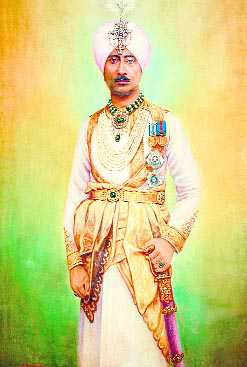
Nawab Ahmad Ali Khan (1908-1947).
Amaninder Pal in chandigarh
In the plains of Malerkotla, you aren't amazed as much by the town’s green, leafy vegetables being sold at home and abroad by laborious arain. What strikes you most is the town's character that unveils itself behind the dust and grime, offering a glimpse through centuries of its existence and prompting amateurs to dig deeper into its Islamic heritage. The once princely state is a Muslim majority town in Sangrur district, a rare distinction it is said to have earned from Guru Gobind Singh-ji, the 10th Sikh Guru.
Ask city resident Raajesh Kakkar what he has got. He says he has arranged the coins since 1762 — when Afghan ruler Ahmad Shah Abdali allowed Nawab of Malerkotla to mint coins — in accordance with their 200-year-old minting chronology. That's a first, if proven by archaeologists and other experts. Kakkar, 53, teaches economics at Government Senior Secondary School in Bagrian village of Sangrur and is the founder convenor of Malerkotla chapter of Indian National Trust for Art and Culture Heritage (INTACH). He has been collecting coins of the Malerkotla state for over 15 years.
“The state was ruled by 22 kings. In the mid-18th century, the state was sort of a protectorate of Ahmad Shah Abdali, who allowed the 12th Nawab Bhikham Khan (1759-63) to mint. The first coin came in 1762,”says Kakkar. “Coins minted during Bhikham Khan and some of his successors’ reign were rarely available and didn’t find mention in any literature of the time. Nobody has arranged them chronologically. After I traced the coins minted during rule of Bhikham Khan and his successor Bahadur Khan (1763-1766), some numismatists claimed that the legends inscribed on them is 'corrupted', thus rejected them as fake. But my research and consultations with Persian experts confirmed otherwise.” Ahmed Ali Khan was the last ruler of Malerkotla (1908-1947). Until then Malerkotla coins bore the inscription in honour of Amhmed Shah Abdali.
Kakkar's claims are buttressed by at least two documents. One is Modern Punjabi Coins, written by British historian RC Temple way back in 1889. An authority on the subject, Temple wrote that he couldn’t trace coins minted during the rule of Bhikham Khan, his successors Bahadur Khan, Nawab Attaullah Khan (1791-1810) and Nawab Wazir Ali Khan, who ruled the state from 1810-1821. The second is Standard Catalogue of World Coins, the standard guide for numismatists and coin collectors.
Jeevandeep Singh, a Ludhiana-based expert on Sikh history, says even the catalogue listed information about coins minted only during seven nawabs of Malerkotla. “Kakkar seems to have joined the dots because reference about Malerkotla coins is very sketchy. Secondly, since Malerkotla was a Muslim-majority state, scholars after Partition were not too enthusiastic about its history,”said Singh. Another expert on Sikh coins Gurprit Singh, author of Coins of the Sikhs: Sri Amritsar Jiyo, also largely agrees with Singh. Gurprit along with fellow numismatists founded National Numismatic Society, Ludhiana, the first such body in North India. “A peculiar feature of the coins minted in the Sutlej states is that all were minted in the name of Ahmad Shah Abdali. This continued even around 100 years after his death. The British didn’t object. Therefore, it becomes almost impossible to attribute the coins to a certain ruler. If anybody has done this with Malerkotla coins, then he is certainly the first one to do so.”
Nawabs of Malerkotla
22 Nawabs ruled Malerkotla, but the coins are associated with only 11 Nawabs. Their names are Nawab Bhikhan Khan (1759-1763), Bahadur Khan (1763-1766), Umar Khan (1766-1781), Asad Ullah Khan (1781-1791), Atta Ullah Khan (1791-1810), Wazir Ali Khan (1810-1821), Amir Ali Khan (1821-1846), Nawab Mehboob Ali Khan alias Sube Khan (1846-1857), Sikander Ali Khan (1857-1871), Ibrahim Ali Khan (1872-1908) and Nawab Ahmad Ali Khan (1908-1947)
Guru’s blessings
Being the only city (except Qadian in Gurdaspur) dominated by Muslims in post-Partition Punjab, Malerkotla is said to have been blessed by Guru Gobind Singh-ji because the then Nawab had stoutly opposed the execution of the Guru's sons. Malerkotla was the only major Muslim principality that escaped the 1947 bloodshed.
What’s on coins?
- The last Nawabs' full name ‘Ahmad Ali Khan Nawab Bahadur’ is inscribed. He was the only one who introduced change in inscription by also adding his name on the the coin.
- A circular in Persian describes contents of the stamp: Zadand Sikka-e-Daulat ba Fazl-e-Rabb-e-Kareem, Ba hukm Wali-e-Malerkotla bar seem (with the grace of God and at the behest of the Nawab of Malerkotla, coins were minted on silver).
- Hukm shud az Qadir-e-bechun ba Ahmad Badshah; sikka zan bar sim-o-zar az ouj-e-mahi ta ba mah. It means: By the order of God, the peerless, to Ahmed Badshah: Strike coin on silver and gold from earth to heaven.



























